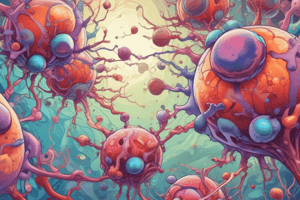Podcast
Questions and Answers
What effect does mitochondrial injury have on intracellular levels?
What effect does mitochondrial injury have on intracellular levels?
- Enhances glycolysis in all cells
- Decreases ATP production and causes necrosis
- Increases reactive oxygen species (ROS) (correct)
- Uncouples electron transport chain from phospholipid synthesis
Which statement is true regarding uncoupling protein-1 (UCP-1) in brown fat?
Which statement is true regarding uncoupling protein-1 (UCP-1) in brown fat?
- It is inactive in newborns.
- It solely facilitates ATP synthesis.
- It allows substrate oxidation without ATP generation. (correct)
- It helps to maintain the proton gradient.
How does the Warburg effect influence proliferative cells?
How does the Warburg effect influence proliferative cells?
- They primarily rely on oxidative phosphorylation for energy.
- They increase mitochondrial respiration rate significantly.
- They minimize glucose uptake to reduce cellular growth.
- They utilize glycolysis to support lipid and protein synthesis. (correct)
What role does brown adipose tissue play in newborns?
What role does brown adipose tissue play in newborns?
What is a consequence of oxidative phosphorylation in cells?
What is a consequence of oxidative phosphorylation in cells?
What role does NADPH oxidase play in the immune response?
What role does NADPH oxidase play in the immune response?
How does the Fenton reaction contribute to free radical generation?
How does the Fenton reaction contribute to free radical generation?
What is the consequence of mutations in the NADPH oxidase genes?
What is the consequence of mutations in the NADPH oxidase genes?
Which of the following statements accurately reflects the role of nitric oxide in inflammation?
Which of the following statements accurately reflects the role of nitric oxide in inflammation?
What substance is primarily responsible for the characteristic color of pus in tissues?
What substance is primarily responsible for the characteristic color of pus in tissues?
Flashcards
Mitochondrial Injury & Oxidative Stress
Mitochondrial Injury & Oxidative Stress
Damage to mitochondria, caused by factors like oxygen deprivation, toxins, or aging, can lead to an excess of reactive oxygen species (ROS) in a cell.
Thermogenin/Uncoupling Protein-1 (UCP-1)
Thermogenin/Uncoupling Protein-1 (UCP-1)
A protein found in brown fat that can uncouple the electron transport chain from ATP production, leading to heat generation.
Oxidative Phosphorylation
Oxidative Phosphorylation
The process where cells use oxygen to break down fuel and create energy (ATP). It occurs in mitochondria.
Warburg Effect
Warburg Effect
Signup and view all the flashcards
Brown Fat
Brown Fat
Signup and view all the flashcards
Respiratory Burst
Respiratory Burst
Signup and view all the flashcards
NADPH oxidase
NADPH oxidase
Signup and view all the flashcards
Pus
Pus
Signup and view all the flashcards
Chronic granulomatous disease
Chronic granulomatous disease
Signup and view all the flashcards
Hypochlorous acid
Hypochlorous acid
Signup and view all the flashcards
Study Notes
Cellular Damage and Cell Death
- Cell damage can result from various factors, including oxygen deprivation, chemicals, drugs, infections, immune reactions, genetic abnormalities, and nutritional imbalances.
- Reversible cell injury involves early functional and structural alterations, which are correctable if the damaging stimulus is removed. This includes generalized cell swelling due to water influx (failure of the Na+/K+ pump) and fatty changes (accumulation of lipids, particularly in the liver).
- Irreversible cell injury leads to cell death, either through necrosis or apoptosis. Necrosis is characterized by cell swelling, membrane rupture, and release of intracellular enzymes. Apoptosis is a programmed cell death process where the cell fragments and is removed by phagocytosis.
Point of No Return
- The point of no return for cellular damage depends on the cell's ability to adapt, the type and duration of the insult, and the involvement of organelles.
- Irreversible injury affects the membranes, cytoskeleton, and DNA, leading to misfolding of proteins and disrupted functions.
Mitochondrial Dysfunction
- The electron transport chain, not always directly linked to ATP production, can be disrupted by thermogenin/uncoupling protein-1 (UCP-1) and can generate heat.
- Proliferative cells utilize glycolysis for respiration instead of oxidative phosphorylation, using intermediates to create lipids, proteins, and nucleotides, supporting rapid growth.
- Mitochondrial problems play critical roles in apoptosis and necrosis, both types of cell death.
DNA Damage
- Damage to nuclear DNA activates p53, an onco-suppressor gene, which triggers DNA repair pathways.
- If repair is impossible, the p53 pathway might initiate apoptosis to eliminate the damaged cell.
- ROS (reactive oxygen species) damage DNA and other cellular components, including proteins and lipids. They can result from radiation, toxins, and other environmental factors.
Oxidative Stress and ROS
- ROS, produced during cellular processes, can damage proteins, lipids, and DNA.
- Oxidative stress is increased during ischemia and reperfusion events when blood flow is restored.
- Phagocytosis utilizes ROS to eliminate pathogens.
- Cell injury can result from ROS overproduction as occurs in ischemia-reperfusion injury.
Phagocytosis
- Phagocytic cells like macrophages and neutrophils utilize ROS, in part, for destroying pathogens and debris.
Chronic Granulomatous Disease
- This is an immune deficiency that affects the ability of phagocytic cells to kill ingested pathogens, producing chronic inflammation due to compromised pathogen elimination.
Pathologic Effects of Free Radicals
- Lipid peroxidation damages cell membranes.
- Oxidative modifications alter protein structure and function.
- DNA damage leads to mutations.
- Unfolded protein response (UPR) can lead to protein misfolding and cell stress.
Cellular Aging
- Aging involves accumulating damage (free radicals, DNA damage, inability to divide, protein modifications) leading to reduced function.
- Replicative senescence describes the limited capacity for cell division.
- Telomeres, short DNA sequences at the end of chromosomes, shorten with each replication and signal cell cycle arrest for normal cells.
- Genetic conditions can prematurely accelerate some aging signs.
Apoptosis
- Apoptosis is normal cell death with no inflammation.
- It allows the body to remove unneeded or damaged cells.
- Mitochondria and caspases are critical components in its execution involving the formation of apoptosome.
Studying That Suits You
Use AI to generate personalized quizzes and flashcards to suit your learning preferences.



